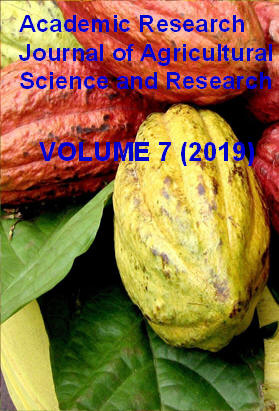|
ISSN: 2360-7874 |
Academic Research Journal of
Agricultural Science and Research |
|||||||||||||||||||
|
Vol. 7(7), pp. 560-568, November 2019 Research Biology of cotton mealy bug (Phenacoccus solenopsis (Tinsley) on cotton plants under the laboratory conditions
1Sileshi Getahun, 1Nurhussien Seid, 1Zemedkun Alemu, 2Workishet Taye, 1Sharew Abate and 3Miesso Hemba.
Ethiopia Institute of Agricultural Research, 1Werer Agricultural Research Center, 2Melkessa Agricultural Research Center, P.O. Box 2003, 3Addis Ababa, Ethiopia. Corresponding Author: e-mail silgeta100@gmail.com
Accepted 31 October 2019
Phenacoccus solenopsis Tinsley (Hemiptera: Pseudococcidae) is one of the invasive insect species, which appeared in Ethiopia 2012, and then widely spread all over cotton growing areas of the country within few years. The current study was done under laboratory condition to study the biology of Phenacoccus solenopsis in Ethiopia by using cotton leaves placed in Petri plates as a feed for the insect. Phenacoccus solenopsis developmental stage and reproduction were observed in detailed at mean room temperature of 26.7-30.8 and relative humidity of 45.3-57.3%. The result revealed that P. solenopsis possess three instars for females and four instars for males. Among these the third instar required longer developmental period (5.3±0.1 day) and the first instar and second instar had nearly similar developmental periods 3.7±0.1, 4.3±0.1 days respectively. The second instar had lowest survival percentage (53.7%) than first and third instar (72.7%, 77.8%) respectively. Female P. solenopsis were differentiated from male at third instar where, male developed cocoon and wing whereas the female remained wingless and its body covered with white dusty. The female has three molting stages and the male has four. Females have fecundity range of (103 to 848) during its reproductive period. The male total life span was (13 to 20 days) shorter than female (30 to 53 days). The present study indicates that management interventions should be taken before third instar developmental period for effective management of this insect. Keywords: Cotton mealbug, crawlers, developmental period.
How to
cite this article (APA Style):
Sileshi G.,
Nurhussien S., Zemedkun A., Workishet T., Sharew A., Miesso H (2019).
Biology of cotton mealy bug (Phenacoccus solenopsis (Tinsley) on cotton
plants under the laboratory conditions. Acad. Res. J. Agri. Sci. Res.
7(7): 560-568
|
|||||||||||||||||||
